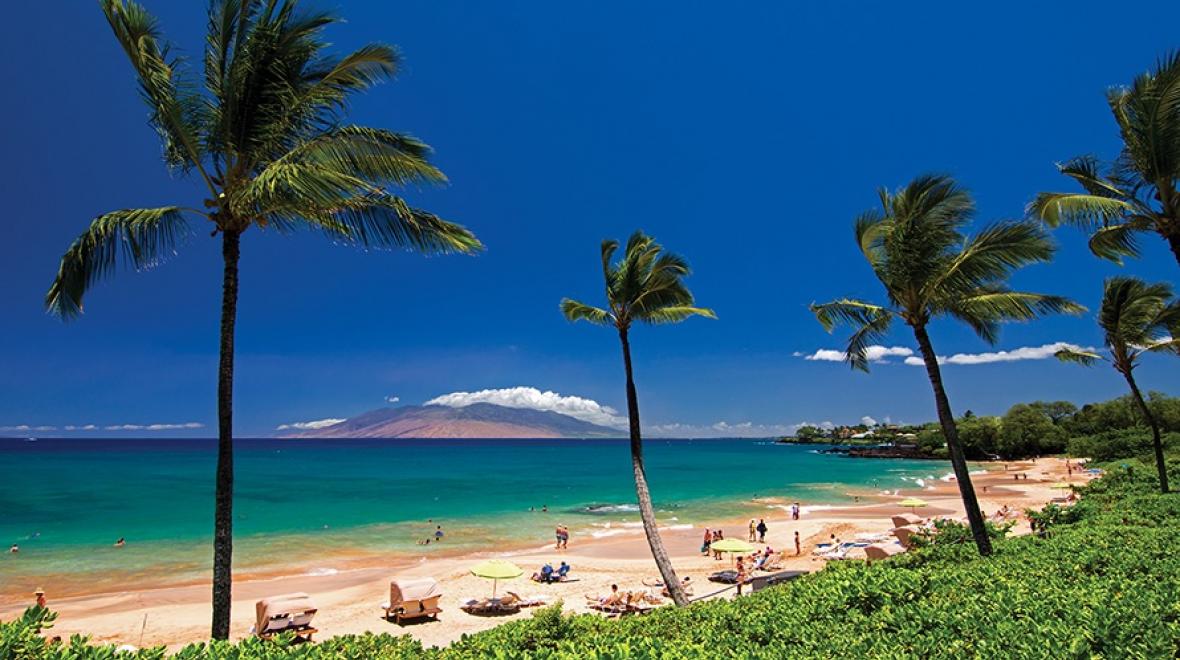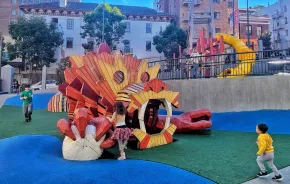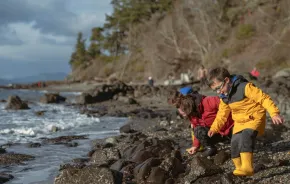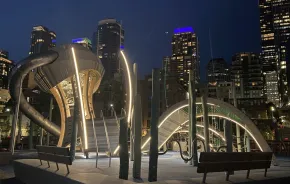
It’s about 5:45 p.m., and a crowd has gathered in the shaded center plaza for the evening lu‘au at the Kā‘a‘napali Beach Hotel. This is a place that harnesses all of the charm of 1970s Hawaii while also making the claim to be the “most Hawaiian” of all hotels in America’s 50th state. The banana-leaf-skirted woman charged with giving my 4-year-old son his first tattoo, a temporary, oily turtle almost too big for his tiny calf, smiles broadly and rolls a pattern across his skin.
Magical Maui tips
Be safe under the sun. The sun can be brutal. Buy everyone a swim T-shirt, with long sleeves for delicate complexions, and don’t forget sunglasses and hats. Buy environmentally friendly sunscreen without oxybenzone, which has been identified as a major contributor to reef die-off.
Steer carefully. Driving on Maui can get hairy — that’s what happens when nearly everyone on the road is a tourist getting to know their rental car. Avoid commuter times at all cost in West Maui. One-lane bridges hug the northern and northwestern coastlines, so drive off the main drags at your own peril.
Cook to save. Maui is an island, and most goods are shipped in at an exorbitant cost. Plan to spend at least $100 for a modest dinner for four at a restaurant. Most places have fridges, if not small kitchens, and cooking on your own can go far. Tip: Stop by the Costco by the airport to stock up before heading to your hotel.
Star this restaurant. Do get a reservation at Star Noodle in Lahaina, where everything on the menu is, indeed, stellar. While you’re exploring the island at large, keep an eye out for fresh fruit, banana bread and macadamia nut tarts. Kids might even get adventurous with a Hawaiian plate lunch: white rice, macaroni salad and a slow-braised meat.
“Ah, Lokomaika‘i!,” she says, turning his passport tag over to reveal the Hawaiian name he has been given by the hotel’s native Hawaiian cultural diplomacy staff. “We don’t see that name much. It means ‘gracious.’”
We went to Maui last winter because I wanted to give my children a cultural experience of the islands beyond what we were able to glean from Moana, Disney’s inspiring film about a girl who listens to her inner voice. Finding cultural authenticity in the course of an eight-day family vacation is a doomed venture, of course. But perhaps my two boys, 4 and 7, could take home something more than a vintage Maui surf shirt and memories from the beach.
You may go to Maui for the tropical paradise, but very quickly you’ll learn the greatest lesson of Hawaiian culture: Hospitality is a supreme cultural force. Hosts and staff everywhere are gracious and go far out of their way to give visitors a safe and delightful stay. If you plan well, you (and your kids) will come back understanding what the all-encompassing force of “aloha” actually means.
You can learn about Hawaiian hospitality on other islands, of course, but Maui, the world’s most popular island destination, is especially blessed. Because of its plum positioning, it offers three Hawaiian islands in one. Maui’s western shores (West Maui), centered around the city of Lahaina, welcome families with soft, warm daily trade winds that feel like kisses on the skin. Its southwestern shores (South Maui) are home to towns such as Wailea that are filled with locals, grand resorts and waters teeming with sea turtles. Up-country is populated by aging hippies, artists and farmers, and boasts sites ranging from botanical gardens to spectacular crater hikes.
Above all, when you travel to Maui as a family, look for the chances to put yourself in the places where the native Hawaiians are the ones telling the stories. In the past few decades, the tourism industry has incorporated native traditions in a way that works for both parties. Several hotels, for example, have on-site cultural ambassadors or hire predominantly native employees to run their programs.
“My job is to give travelers the ‘cultural baggage’ to take home with them,” says Clifford Nae‘ole of The Ritz-Carlton in Kapalua, the state’s first hotel cultural adviser and a 30-year veteran of the cultural tourism industry.
So how should you structure your Maui vacation to make the most of its cultural and natural riches? Here are my top recommendations by age.
For babies and toddlers
Maui makes being a new parent easy. If you can wear a child, you can take them just about everywhere. Banyan Tree Park in Lahaina — home to a single banyan tree planted in 1873 to commemorate the arrival of American missionaries on the island — now occupies 0.66 acre and is a fun place to walk with a shave ice in hand. Also consider Baby Beach, which, as the name suggests, is ideal for babies thanks to a reef that keeps the water calm with few to no waves. Look up “Pu’unoa Beach” if you have trouble finding this nickname.
Try Ululani’s Shave Ice in Lahaina for the fluffiest snow, and Maui Animal Farm for accessible wildlife.
For aquarium-loving toddlers, try the Maui Ocean Center for its tropical fish exhibit and sea turtles. You can also treat yourselves, as we did, by watching sea turtles that swim at many of the island’s beaches.
For kids under 13
School-age children will adore Maui. Beyond the guaranteed fun at local beaches, whale watching is a highlight. Check the website Maui Whale Watching to find out about expeditions leaving Maui for nearby Lana‘i and Moloka‘i. Humpback whales breed and nest in the sweet spot between the islands in the winter months (January–March). Several operators host tours directly from hotels in Kā‘anipali, or look into PacWhale Eco-Adventures.
On the cultural side, a lu‘au is a must for first-timers. My 7-year-old wanted to go to one every evening after attending The Old Lahaina Luau. Staged directly on the water at sunset, the production tells the story of Hawai‘i’s settlement by Pacific Islanders, the arrival of missionaries in the 19th century, the crackdown on Hawaiian culture and the state’s rediscovery of its native traditions, all through dance.
For teens
I ditched my husband and kids for a morning to take a private mermaid lesson at Hawaii Mermaid Adventures. The tour of coral reefs with a monofin is led by a marine biologist mermaid and includes a photo session. If channeling your inner Ariel is not your thing, Turtle Town in South Maui is a great place to snorkel with sea turtles.
For a higher-octane adventure, you can zip along on a tour by Skyline Ziplines, the world’s first zipline tour company, which sends you careening across your choice of island habitats.
If you can tear teens away from the surf, the Lahaina Historic Tour is a fun morning diversion through the island’s most historic port, which changed from a whaling to whale-watching center.
And for the ultimate finish to your Maui novice tour, consider watching the sunrise at Haleakalā Crater, if you can handle the 2:30 a.m. wakeup call. Tip: As of Feb. 1, 2017, you need reservations though the National Park Service.
Where to stay on MauiMost families prefer West Maui and its beaches as their home base, although families with older children may enjoy the adventurous trek along the famous winding road to Hana (full disclosure: my stomach didn’t survive it). More residents are opting to place their homes on property-sharing sites, so Kihei and South Maui are prime for that option but lack nearby access to the best beaches and sites. Great value: Kā‘anipali Beach Hotel KBH is a gracious, charmingly retro option with a fun, whale-shaped pool. My kids adored its passport program, which rewards them for participating in traditional Hawaiian activities, like learning the hula or taking a ukulele lesson. The rooms are not great (scratchy sheets), but you won’t want to be in your room here. From $201 a night. Mid-price: Napili Kai Beach Resort Crying as you sit on the lanai looking out at gorgeous Napili Bay is OK — everybody does it. Many families return year after year to this gem of a property, which feature newly renovated rooms, many of which overlook the churning ocean. Prepare to dine with perky cardinals at its charming beachside restaurant. Lounge around the pool and catch a performance of the longest-running keiki show in the state: Hawaiian children singing traditional songs. From $390. Splurge: The Ritz-Carlton, Kapalua The resort was originally intended to be beachfront, but the discovery of hundreds of graves on its western hillside prompted local outrage and a new plan. Now this resort leads the pack in terms of native Hawaiian cultural activities, including the Celebration of the Arts cultural program, which make up for its five-minute walk to private Kapalua Bay beach. You’ll find Ritz-like hospitality; a killer pool with multiple cabanas for shade; an Environmental Ambassador program, which allows you to drop off the kids; and a 1.75-mile hike along a craggy ocean cliffside. From $489. Airbnb and VRBO options If you’d like to avoid hidden resort fees, crowds and matching towels, you can always search for your perfect homestay on the island. You’ll find the highest concentration of private rentals on the island in South Maui between Wailea and Kihei. One warning: There are many reports of abysmal service at these homes, according to discussion boards, and you might be playing a part in the displacement of native populations. Gracious hospitality is what Maui does best, so consider choosing an option where you can experience that. |











